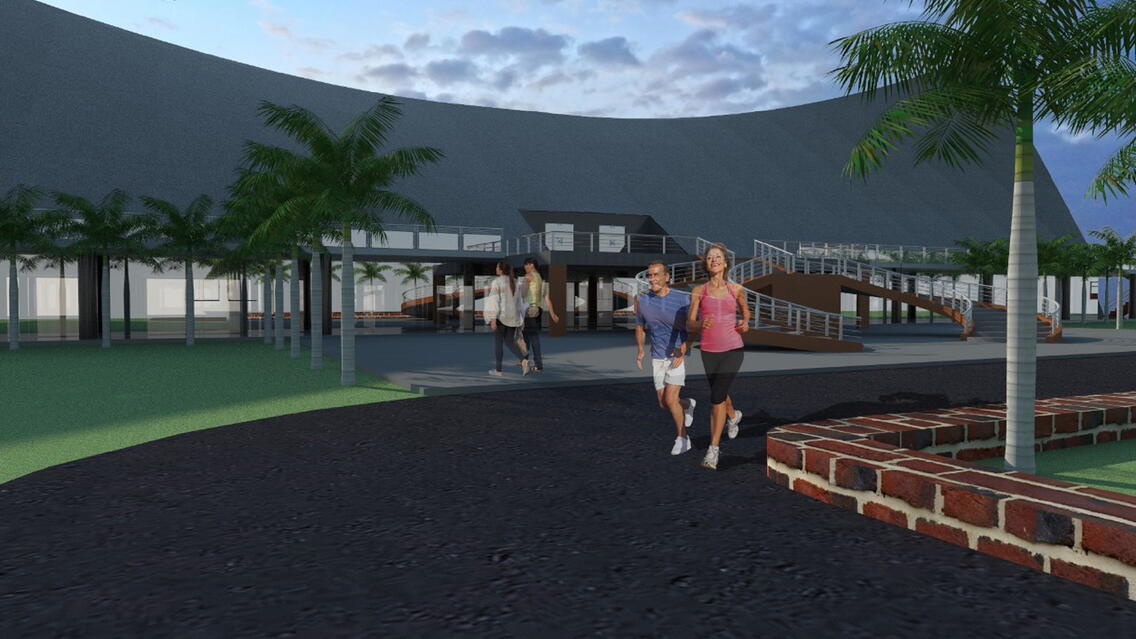Gadang International Sport Center (GISC) is a sport center that combines local cultural architecture of the gadang house as its roof. Gadang International Sport Center has two main room sections consisting of two floors. The first floor is a large room with a roof like a gadang home that is designated as a sports center such as badminton, basketball, futsal, and volley with a capacity of 3000 m2 and can accommodate about 1000 seats. While the ground floor is used as a sport shopping center which is so vast with a beautiful design by combining glass material as a wall which make it looks modern.
Gadang International Sport Center (GISC) is certainly made based on processes that are not easy. The initial idea of making this sport center by combining the local culture of the roof of the gadang house started from our concerns about buildings in Indonesia which with the development of construction technology and massively increasing construction of buildings and infrastructure often ruled out Indonesian local architecture. On the other hand, the use of international architectural concepts is widely used which makes the creation of local Indonesian architecture lost its prestige. Therefore, we reinvigorated the local cultural architectural by combining the roof structure of the gadang house at Gadang International Sport Center (GISC) in hope that the concept of local architecture can be improved in our own country.
The process of making the structure of Gadang International Sport Center (GISC) is using Tekla software and there are some components that using sketchup software. Manufacturing with tekla software starting from the creation of the grid to determine the location of the column and the placement of the dimentions of the structure. Then manufacture of bottom structures of the building which includes the foundation, footing, and bottom floor plates. In this section we have a slight change of drawing from the beginning to this structure by reducing the number of pillars that were originally used every grid which is 5 m away to 10 m by adding the pillar dimension. Then proceed to the structure of pillars, beams and plates upstairs. In this section, we did not experience such a big problem because we just continuing the work from the previous one, for example the placement of the pillars, we just add the pillars on the foundation part that has been installed. Then move to the roof structure work, in this section of course we had problems about the placement of structures that resemble the form of gadang house roof. The roof shape of the Gadang House is accentuating the tapered triangle structure at the end, but the components / icons on the tekla software can not reach it, so we made use of tools such as temporary lines, grids, etc. to create a gadang roof. Then after that, in the finishing work like fencing, stairs, and landscaping. In this work we encountered problems especially on the manufacture of ladder structures. Here we also change the structure of the stairs. Initially we made the ladder using the components of the tekla software, but then the various problems encountered such as unsuitable dimensions of size, design that did not suit our desires, and distress in placement to upper floor structure. At the end, the ladder structure that we wanted we imported the components from sketchup warehouse. Then for landscape, we used sketchup software by importing from tekla file.
While modeling the structure of Gadang International Sport Center (GISC) we are well awared that this indirectly can improves the capabilities and creativities that we may need in the world of work later. In addition, we believe that in our goodwill in making the model of the Gadang International Sport Center (GISC) structure indirectly creates an emotional tie to the indigenous culture of Indonesia that needs to be maintained with the world of construction in Indonesia. We hope this project becomes one of the efforts in supporting the development of construction technology but still heed the values of local wisdom, so the concept of local cultural architecture like this can continue to prosper and survive in their own country.
The process of making this project can certainly be done on the guidance of our supervisors, who have helped both in terms of materials such as computer lab lending and for ideas of their thinking then this project can be created. We see that our project is created because of concerns about the construction industry in Indonesia that has already begun to override local cultural architecture, and we are very satisfied with the results of this project. We hope that in the future we can create any other building projects which also applying the concept of local Indonesian architecture on it, and later can be applied in the real world.
